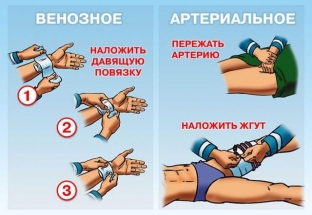The need to provide first aid for bleeding is due to the danger that a certain type of bleeding can pose to human health and life. Therefore, it is important not only to know what the danger of bleeding is and what kind of assistance should be provided to a wounded person, but also to be able to determine the type of bleeding. You will learn about the characteristic signs of existing types of bleeding and how to provide first aid in case of their occurrence from the article prepared for you by estet-portal.com.
Types of bleeding – characteristics
Because first aid for venous bleeding is different from first aid for, say, arterial bleeding, you need to be clear about which vessels you are experiencing.
There are four main types of bleeding:
- capillary;
- venous;
- arterial;
- internal.
The danger of bleeding is:
- acute blood loss;
- risk of infection;
- formation of a pulsating hematoma;
- air penetration into the damaged vessel.
Determine the type of bleeding:
- Capillary (minor and uniform discharge of blood from the damaged surface).
- Venous (even and rapid outflow of dark red blood without signs of gushing; clots may form).
- Arterial (a pulsating (sometimes intermittent) jet of bright red blood that flows out at high speed).
- Internal (pale skin, cold sweat, dizziness, weak pulse, fainting, shallow breathing; blood does not flow out). If the bleeding is localized in the lungs, there is blue skin and mucous membranes, rapid and / or shortness of breath, coughing up blood. Bleeding into the abdominal cavity can be manifested, in addition to the main signs, by vomiting with blood, tachycardia, and a decrease in pressure. Hematomas occur when there is bleeding into large muscles.
First aid rules depending on the type of bleeding
As a rule, the maximum danger of capillary bleeding is not blood loss (it is minimal), but infection.
Therefore, in case of damage to small vessels, it is enough:
- wash the wound with water (of course, clean);
- treat the edges of the wound with an antiseptic;
- apply a gauze bandage.
If you have determined that you are dealing with venous bleeding, the procedure for dealing with this type of bleeding is as follows:
- pressure dressing (aseptic);
- if a pressure bandage does not help, a tourniquet or a rolled towel, belt, etc. is applied to the soft lining. (location – below the damaged area) with a note attached with the overlay time; leave the tourniquet for no more than 1 hour in cold weather and no more than 2 hours in hot weather.
One of the most dangerous types of bleeding is arterial, because in this case the risk of death as a result of blood loss increases significantly. In this case, you need:
- only if there are no fractures – raise a limb;
- apply a tourniquet (or equivalent) above the injury site;
- while searching for material for the tourniquet, you can press the artery (also above the injury site) at the site of the pulsation;
- if certain arteries (brachial, ulnar, popliteal, or femoral) are compromised, the limb can be raised and locked in a flexed position.

If symptoms suggest the presence of internal bleeding, immobilize the victim, namely:
- in case of hemorrhage in the thoracic region – half-sitting position + knee roll;
- with hemorrhage in the abdominal cavity – lying position.
The cold applied to the supposed site of the bleeding will help to ease the bleeding somewhat.
An ambulance should be called immediately for any type of bleeding other than capillary. Remember that reaching into the wound with your hands, trying to remove any objects from it, or removing a bandage soaked with blood is prohibited.






Add a comment